The Elkhart-Goshen Metro Area
The Area
The Elkhart-Goshen Metropolitan Statistical Area (metro), comprised of just Elkhart County in northern Indiana, borders Michigan and is adjacent to the South Bend–Mishawaka metro. Elkhart and Goshen are the two population centers, while the smaller Nappanee and Middlebury are two of the larger Amish settlements in the United States.
Elkhart County grew consistently throughout the twentieth century and reached 188,779 residents by 2003 (exhibiting a 3.3 percent growth over Census 2000). Projections from the Indiana Business Research Center indicate that Elkhart’s population growth will continue at rates higher than the state, particularly among those under age 45.
Between 2000 and 2003, the metro area gained nearly 6,000 residents through migration and natural increase (births minus deaths). Total net migration during that time period was 620 people. Elkhart County experienced a net influx of 3,172 international migrants, the third largest number in the state. Meanwhile, net domestic migration declined by 2,552 people, the state’s sixth largest decline in domestic migration.
Number of Hispanics on the Rise
Between 1990 and 2000, the number of Hispanics in Elkhart-Goshen increased 455.9 percent. This growth of over 13,000 people ranked third in the state. With such a large increase, Hispanics jumped from less than 2 percent of the Elkhart-Goshen population in 1990 to nearly 9 percent in 2000, the largest percentage point change in the state. By 2002 (the latest year for which data is available), the Hispanic population had reached 18,990—a 2,690 person increase from Census 2000, which brings the Hispanic share of total population to 10.2 percent (compared to 3.8 percent statewide).
Language is one implication of this demographic shift. While 85.6 percent of the population spoke only English in 2000, Spanish became dominate among those speaking another language at home (see Figure 1). The number of people speaking Spanish at home grew 402.6 percent between 1990 and 2000, compared to 15.3 percent for other non-English languages (mostly attributable to the Amish communities who speak Pennsylvania Dutch or some other Germanic language) and 9.6 percent for those who use English alone.
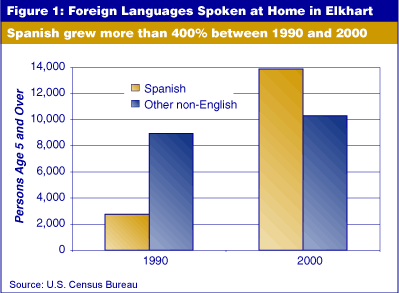
Rapid growth in linguistically isolated households (where all members 14 years old and over have at least some difficulty with English) is cause for concern. Isolated households increased nearly 150 percent during the past decade to encompass over 2,400 families. One can extrapolate from Figure 2 that nearly all of the linguistically isolated households are speaking Spanish.

Industrial Mix and Jobs
Even though Elkhart was built around an island near the convergence of the St. Joseph and Elkhart rivers that resembles an elk’s heart (hence, the name Elkhart), the true heart of the city is manufacturing. As of the third quarter of 2003, manufacturing had fallen to just over 20 percent of employment statewide and 11 percent nationally, yet over half of all Elkhart County employees worked in manufacturing. Recreational vehicles (RVs) and manufactured housing are the products of choice. Four of the five largest companies in the county (Forest River Industries, Fairmont Homes, Monaco Coach Corp., Holiday Rambler and Coachmen Industries) are in the RV industry, with several other RV and manufactured housing companies in the top 20, according to the Elkhart Chamber of Commerce. In recent news, the Forest River RV manufacturer has announced plans to build three new plants in Goshen by August of next year.
Looking at the monthly data for May 2004, 58,300 people were employed in manufacturing, posting a gain of 800 workers since May 2003 (see Figure 3). The largest manufacturing subsector—transportation equipment manufacturing—grew by 1,400 jobs, which was offset by losses elsewhere. Overall, nonfarm employment increased by 2,000 to a total of 122,300 jobs.
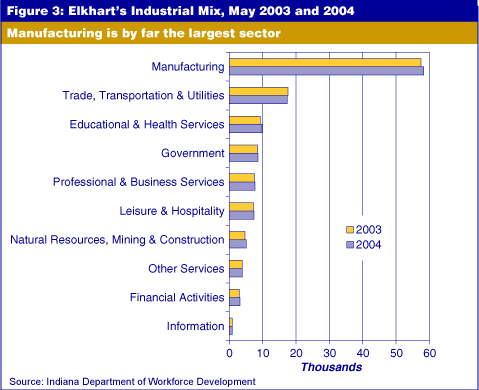
According to a recent Manpower Employment Outlook Survey, over half of Elkhart companies interviewed plan to hire more employees (the statewide average was 33 percent), and none were planning cutbacks during the third quarter of 2004. This ranked Elkhart-Goshen’s employment outlook sixth in the nation.
The improving business scene, combined with rumors of rising interest rates
and steel prices, has caused an upswing in commercial building projects. According
to Elkhart’s newspaper, The Truth, 16 commercial building projects are
underway in Goshen this year, almost reaching the total for all of 2003 and
at a value worth twice as much.
Over 91,000 people both lived and worked in Elkhart County in 2003. Because
of its close ties to South Bend and Mishawaka, St. Joseph County sends the
most workers into Elkhart (see Figure 4). In addition, over half of those
commuting out of Elkhart work in St. Joseph County.
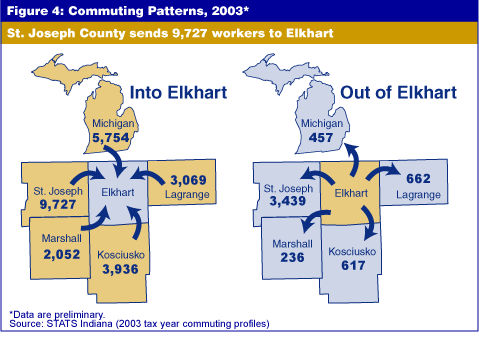
Income and Wages
At $623, the average weekly wage in the Elkhart-Goshen metro was a few dollars less than the state average for the third quarter of 2003 (see Table 1). Most industries fell below the statewide average, led by arts, entertainment and recreation with a difference of $177 per week. Manufacturing wages ($696) were also significantly less than Indiana’s with a weekly difference of $139. On the flip side, those managing companies and enterprises earned $1,277 per week, averaging $225 more than the state average.
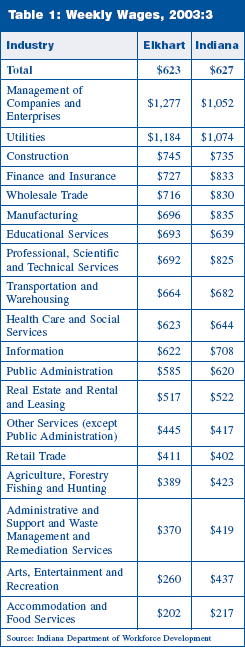
Despite wages slightly below the state average, the Elkhart-Goshen metro was ranked first among the nation’s metro areas for housing affordability by the National Association of Home Builders for the first quarter of 2002 (the latest quarter for which the housing opportunity index has been calculated). This index calculates affordability based on the annual median family income and average home ownership costs in a given area. As it turns out, a family earning the median family income can afford 94.9 percent of the housing in Elkhart-Goshen (trailing right behind were Kokomo, Ind., at 94.8 percent and Fargo, N.D., at 94.5 percent).
For the past twenty years, Elkhart’s per capita personal income (PCPI) has slightly exceeded the state (see Figure 5). However, Elkhart-Goshen did not keep pace with the boom of the late 1990s and has yet to regain its lost ground. As of 2002, PCPI for the county was $27,665, or 98.7 percent of the state’s average.
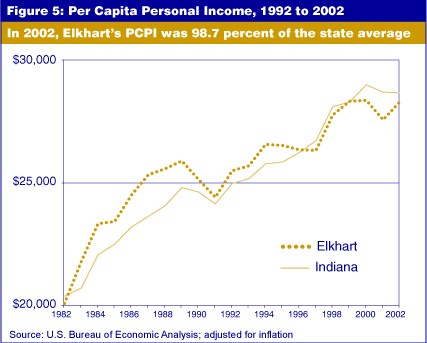
Rachel Justis
Managing Editor, Indiana Business Research Center,
Kelley School of Business, Indiana University
